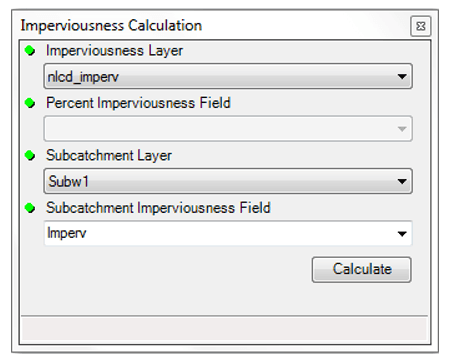Imperviousness Calculation Tool
The "Imperviousness Calculation" tool works with a grid or a polygon feature layer dataset that represents surface imperviousness to find the area-weighted average surface imperviousness of the model subcatchments. In an imperviousness raster, each cell value represents the fraction (or the percentage) of impervious area within that cell. The tool requires a dataset that represents imperviousness (raster or polygon feature layer) and the subject subcatchment layer as inputs. If the imperviousness dataset is a polygon feature layer, then the attribute field containing the imperviousness value needs to be specified by the user during calculation. In addition, an attribute field name needs to be specified where the tool will preserve the calculated imperviousness value for each subcatchment. Users may assign a valid field name from the available columns in a drop-down list or insert a new field name. The interface of this tool looks like the following Fig. 96.

Fig.96: Subcatchment Imperviousness Calculation Tool window
The characteristics of the required input features in the Imperviousness Calculation tool are:
Imperviousness Layer
This is either a raster or a polygon feature dataset that contains imperviousness values of the model subcatchment area.
Imperviousness Field Name
This is an attribute field available in the imperviousness feature layer which contains the imperviousness values of the model subcatchment areas. It is not applicable if the imperviousness dataset is a raster.
Subcatchment Layer
This is a polygon feature layer that represents the model subcatchments.
Subcatchment Imperviousness Field
This is an attribute field available in the subcatchment layer in which the slope calculation tool will store the calculated imperviousness values. If a new field name is assigned, then it will be added to the attribute table of the subcatchment layer.
